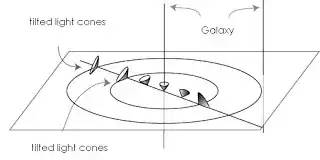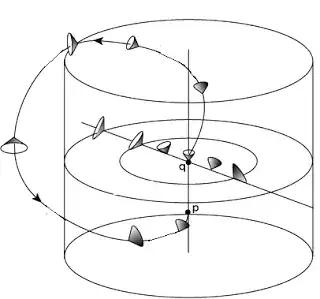I am here to clarify myself about the role of the observer in Gödel's solution (1949) of Einstein's field equations.
The Universe we are dealing with is anisotropic, since the axis of rotation defines a directional preference, while still homogeneous, as every observer is equivalent. The last fact is driving me crazy, as it always does when I have to deal with some formulation of the cosmological principle. In this particular case, though, things get even weirder and harder to grasp.
Every observer can perceive the whole Universe (modelled as a uniform distribution of dust) rotating around himself, since the homogeneity of the solution allows us to fix the axis of rotation wherever we want, not altering its direction.
As shown in the previous picture, once we have chosen (and here's the big deal) a position for the observer, we have that its light-cone is aligned with the axis of rotation, while the light-cones surrounding him start tilting until they reach a critical radius, where they intersect spatial base vectors and allow closed time-like curves (CTCs) to exist. As an observer, I can easily (whatever that means in this context) perceive a rocket which travels along one of those CTCs, since I see his light-cones tilted.
My doubts precisely regard what happens If we swap the roles of the observer and the observed. Consider the rocket as the new observer and the "central" observer as the new observed. Since the solution provides us a homogeneous Universe, we must consider the axis of rotation fixed on the rocket's position at any given spacetime point it gets to. Well, that's quite a problem. Having the axis fixed at its position, the rocket always perceives its light-cone as non-tilted, while the central observer's one gets more and more tilted as the rocket gets far from him. The point is the following: if this universe is homogeneous, thus we can consider every point of it as its center of rotation, how can a body go through a CTC? Does the rocket go through the CTC just in the reference frame of the central observer? How can I figure the situation from a physical point of view without contradicting myself? Can, anyhow, an observer find himself going through a closed time-like curve? Does the homogeneity prevent this?

